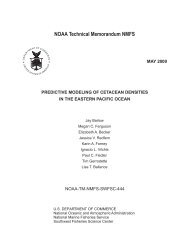NOAA Technical Memorandum NMFS - Southwest Fisheries ...
NOAA Technical Memorandum NMFS - Southwest Fisheries ...
NOAA Technical Memorandum NMFS - Southwest Fisheries ...
Create successful ePaper yourself
Turn your PDF publications into a flip-book with our unique Google optimized e-Paper software.
vocalizations detected by the acoustics team (Table 9, Fig. 19). The mean acoustic<br />
detection distance was 0.58 nmi (SD ± 0.67), with a maximum detection distance of 1.5<br />
nmi (Table 10). L. borealis was found to produce echolocation clicks and burst pulses<br />
(Fig. 20). Whistles were not detected in any of the seven acoustic detections of L.<br />
borealis (Table 11). The mean group size for vocal schools of L. borealis was 27.3<br />
animals, which was significantly larger than the mean group size of 7.8 for visual (only)<br />
dolphin schools (Mann-Whitney test, U=16.5, p=0.021, Table 12).<br />
Feresa attenuata, the pygmy killer whale, was encountered in the tropical waters<br />
of the Pacific Ocean (Fig. 35). There were a total of six visual detections of F. attenuata<br />
during the combined surveys, of which 33.3% produced vocalizations detected by the<br />
acoustics team (Table 9, Fig. 19). The mean acoustic detection distance was 1.0 nmi (SD<br />
± 1.0), with a maximum detection distance of 1.75 nmi (Table 10). F. attenuata was<br />
found to produce whistles, echolocation clicks, and burst pulses (Fig. 20). Both acoustic<br />
detections of F. attenuata included all three vocalization types (Table 11). The mean<br />
group size for vocal schools of F. attenuata was 24 animals, which was larger (but not<br />
significantly) than the mean group size of 7.9 for visual (only) groups (Mann-Whitney<br />
test, U=0, p=0.064, Table 12).<br />
Berardius bairdii, the Baird’s beaked whale, was encountered in the temperate<br />
waters of the Pacific Ocean (Fig. 36). There were a total of seven visual detections of B.<br />
bairdii during the combined surveys, of which 28.6% produced vocalizations detected by<br />
the acoustics team (Table 9, Fig. 19). The mean acoustic detection distance was 1.1 nmi<br />
(SD ± 0.84), with a maximum detection distance of 1.7 nmi (Table 10). B. bairdii was<br />
found to produce echolocation clicks and burst pulses (Fig. 20). Whistles were not<br />
detected during either of the two acoustic detections B. bairdii (Table 11). The mean<br />
group size for vocal schools of B. bairdii was 16 animals, which was larger (but not<br />
significantly) than the mean group size of 7.6 for visual (only) groups (Mann-Whitney<br />
test, U=2, p=0.245, Table 12).<br />
Mixed species groups of Stenella attenuata and S. longirostris were included as a<br />
separate category due to the large number of schools encountered and the importance of<br />
these dolphin schools in relation to the tuna purse-seining industry. Mixed schools of S.<br />
attenuata and S. longirostris were encountered in the tropical waters of the Pacific Ocean<br />
(Fig. 37). There were a total of 76 visual detections of S. attenuata/S. longirostris during<br />
the combined surveys, of which 94.7% produced vocalizations detected by the acoustics<br />
team (Table 9, Fig. 19). The mean acoustic detection distance was 3.02 nmi (SD ± 1.55),<br />
with a maximum detection distance of 6.4 nmi (Table 10). S. attenuata/S. longirostris<br />
were found to produce whistles, echolocation clicks, and burst pulses (Fig. 20). All<br />
acoustic detections of S. attenuata/S. longirostris included whistles, and 25.1% of<br />
detections included echolocation clicks and/or burst pulses (Table 11). The mean group<br />
size for vocal schools of S. attenuata/S. longirostris was 347.9 animals, which was larger<br />
(but not significantly) than the mean group size of 131.5 for visual (only) dolphin schools<br />
(Mann-Whitney test, U=76.5, p=0.128, Table 12).<br />
For the combined single-species dolphin schools, 77.9% were vocal (Table 12).<br />
Group size of vocal dolphin schools was significantly greater than group size for nonvocal<br />
dolphin schools (Mann-Whitney test, U=55990, p









